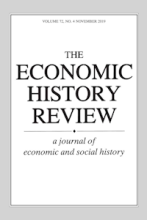New Perspectives on the Contribution of Sanitary Investments to Mortality Decline in English Cities, 1845–1909, Toke S. Aidt, Romola J. Davenport and Felix Gray, Economic History Review, Vol. 76(2) pp. 624-660 (2023)
Health improved in English cities in the last third of the nineteenth century, in tandem with substantial increases in public spending on water supplies and sanitation. However previous efforts to measure the contribution of public expenditures to mortality improvements have been hampered by difficulties in quantifying public health investments, and the lack of mortality data for specifically urban populations. We improve upon the existing evidence base by (1) creating measures of the stock of Urban District sanitary capital, by type, based on capital expenditure flows, rather than loan stocks; (2) using mortality and capital stock data that relate to the same administrative units (Urban Districts); and (3) studying the period 1880-1909 as well as the earlier period from 1845. The stock of sewerage capital was robustly related to improvements in all-cause mortality after 1880. The size of this effect varied with the extent of public investment in water supplies, suggesting complementary between the two assets. For the period 1845-1884 investments in water were associated with declines in infant and child mortality but the effect was much smaller and less precisely estimated in later decades. Our results suggest that improvements in water and sewerage targeted different transmission pathways for faecal-oral diseases.

